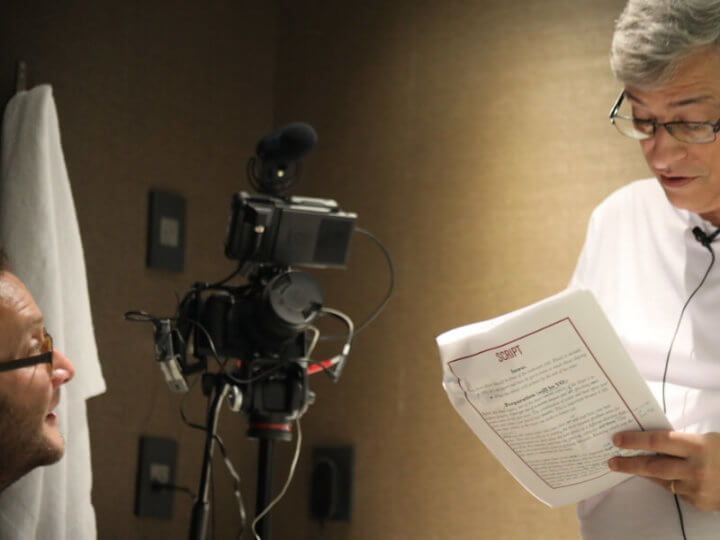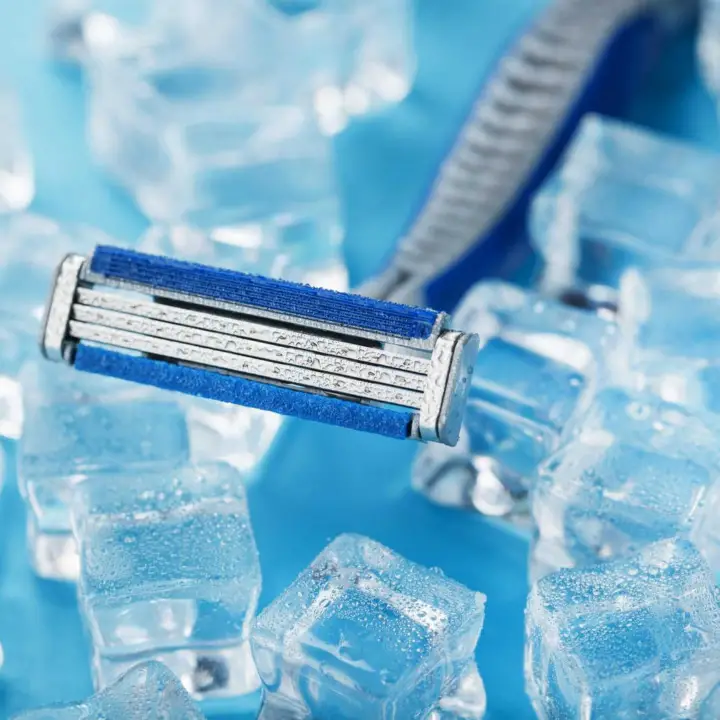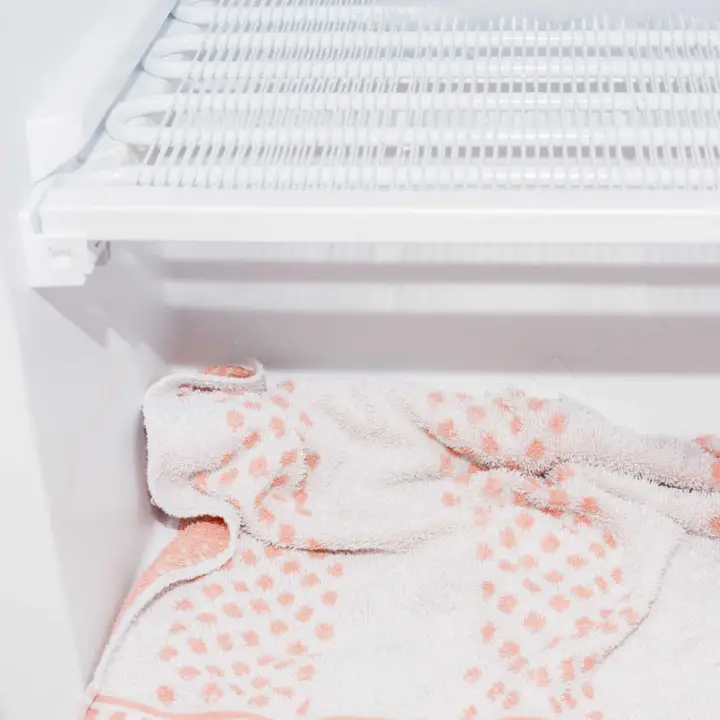
Using ice after shaving has been gaining popularity recently as a soothing finish to a shaving routine. It can help reduce inflammation, prevent razor burns, and leave your skin feeling refreshed.
In this article I’ll discuss everything you need to know about using ice after shaving – from its benefits and how to prepare it to precautions to take and alternatives to consider. I will also debunk common myths associated with using ice after shaving and provide final recommendations for incorporating ice into your shaving routine.
My Ice And Shaving Story: Ice During A Shave

Back in 2018 I worked with the Cremo company to help them shoot some videos about shaving. We used the hotel that Cremo had used before as a set for shoots, as they discovered the bathrooms were big, attractive, and well-lit.
While I was shaving during the shoot, I gave myself a little nick. Everyone froze for a second, not quite knowing what to do. I said “someone go to the ice machine and get a bag of ice!” I applied a cube to the nick for a few seconds and it stopped the bleeding and swelling enough for me to finish the shoot.
For those who experience excessive bleeding, ice can help stop the bleeding and reduce swelling. In addition, applying ice after shaving can improve your skin’s elasticity and reduce the appearance of scars, making it an excellent addition to your skincare routine.
Ice After Shaving
Ice is a natural remedy for soothing irritation and inflammation caused by shaving. After shaving, applying ice to the skin immediately can reduce swelling and pain. When used frequently, it can also help reduce redness and inflammation. Using a cold compress or wrap on the shaved area can provide additional relief.
However, it’s important to follow up with a moisturizer to restore the skin’s suppleness and protect it from further dryness. This shaving hack is an easy and inexpensive way to achieve a smooth and irritation-free shave, making it worth trying out for anyone looking to improve their shaving experience.
Benefits Of Using Ice After Shaving
Using ice after shaving is a simple yet effective way to soothe and calm the skin. Ice can help reduce inflammation and irritation caused by shaving, as well as reduce razor burn and bumps.
Additionally, ice can help reduce the appearance of razor rash, which can be unsightly and uncomfortable.
How To Use Ice After Shaving
There are three methods of incorporating ice into your post-shave routine:
- Using ice cubes directly;
- Using an iced washcloth;
- Using an ice roller.
Let’s tackle each method in a little more detail.
Method 1: Ice cubes

Method 1 involves wrapping ice cubes in a clean, relatively thin cloth as a compress and gently applying it to the shaved area for a few minutes (no more than ten minutes). The cold temperature of the ice constricts blood vessels reducing swelling, promoting healing and leaving your skin looking smoother and healthier.
It’s important to avoid leaving the ice on the skin for too long or applying it directly without a barrier, as this can cause damage or discomfort. Incorporating Method 1 into your post-shave routine regularly can lead to noticeable improvements in your skin’s appearance and health.
Method 2: Frozen Washcloth

Here’s a technique I learned from a barber in Las Vegas: soak a hand towel in water, wring it out, then place it in the freezer before you start your shave. After you’re finished shaving, take the towel out of the freezer and place it on your face. It’s a great, refreshing sensation for your face, especially during the hot days of summer.
After you take the towel out of the freezer you can also sprinkle a little of your favorite cologne onto it, then apply to your face. The alcohol will act as an antiseptic but because of the cold temperature of the towel it won’t penetrate too far under the skin and you won’t get that sting. Some have suggested adding aloe vera, green tea, or chamomile tea to enhance the cooling and soothing effects on your skin.
Method 3: Ice roller

[Note: Amazon links here are Sharpologist affiliate links.]
I first learned about ice rollers from my wife. She regularly kept a small one in the refrigerator so I tried it after shaving. The results were uninspiring (too small and not cold enough) but it got me curious about the potential benefits.
Using an ice roller after shaving can be a convenient and effective way to reduce inflammation and redness on the skin. Ice rollers are easy to use and do not require any prep work or special equipment.
Simply place the roller in the freezer for a few hours before using it to roll over the shaved area. The cold therapy helps to soothe the skin, appear to tighten pores due to the constriction of piloerector muscles, and improve circulation for a brighter complexion.
Some popular, highly-rated ice rollers available on Amazon include:
Eli with Love Premium Facial Ice Roller
In addition to reducing inflammation, ice rollers can also provide relief from razor burn, itching, and redness. They can also be used to treat migraine headaches.
It is important to follow up with a moisturizer after using an ice roller to lock in moisture and prevent dryness.
Precautions To Take When Using Ice After Shaving
Using ice after shaving can be an effective way to soothe the skin and reduce redness, but it also requires some precautions. Applying ice directly on the skin can lead to irritation or even frostbite if used without caution.
One major concern when using ice is that people with sensitive skin should avoid using ice after shaving: it can cause cuts and further irritation in the skin.
To avoid any potential complications, it’s important to test the ice before applying it to your skin. Additionally, there are a few drawbacks to using ice after shaving that should be considered. For example, it can slow down the healing process and make skin dry. Overall, while using ice after shaving may work for some people, it’s important to weigh the potential benefits and drawbacks before giving it a try.
Debunking Common Myths About Using Ice After Shaving
Common myths about using ice after shaving include claims that it can close pores, prevent ingrown hairs, and even prevent acne. These claims are largely false and have no scientific evidence to back them up. Overall, using ice after shaving is a safe and effective way to soothe the skin and reduce irritation when done properly.
Related Post: Do Skin Pores Really Open And Close? The Science
Conclusion
Using ice after shaving is an excellent way to soothe and calm your skin, leaving it feeling refreshed and rejuvenated. The benefits of using ice after shaving are numerous, including relieving inflammation and reducing redness. Preparing the ice for shaving is easy, and you can add ingredients to it for extra benefits.
However, precautions must be taken when using ice after shaving, such as avoiding it if you have sensitive skin or any open wounds.

Thank you!
Hey, Mark.
Thanks for this shaving Icecapade article. I have never heard of adding ice to a shave. I do not have redness issues from shaving, so, I will pass on filling my sink with ice. But learning is a premium from the Sharpologist world.
Two questions: Who keeps ice in their bathrooms? Many people live in houses where they shave on one floor and have their freezer on another floor. Second, why no mention of using a styptic pencil? It has always worked for me in stopping the occasional nick. And for the third of my two questions who wants to put ice on your face in the winter?
I go to the kitchen for the ice. I have single story house. There was no mention of prep, proper lather, styptic pencils. It was an article on ice shaving. I like the ice as it is refreshing. I use a space heater in the bathroom in winter. My bathroom is much warmer in winter than in summer.
I take be bold, shave cold to the extreme. I have a plastic scuttle with frozen water in it. (Fill a little, freeze, repeat) I put back in freezer after shaving, doesn’t thaw enough to bust. I make my lather in a bowl. Then put brush into ice scuttle. Then shower.
I put a couple of ice cube trays into the sink, to shave with. Then put ice in my rinse water. This has really helped my irritation/redness.
So, “…cold therapy helps to … tighten pores…” but “Common myths about using ice after shaving include claims that it can close pores…”
So it can “tighten” pores, but not “close” them? Interesting distinction, I think.
Yeah I need to do a better explanation of that. Cooler temperatures can temporarily give the appearance of smaller pores due to the way cold constricts piloerector muscles. I’ll edit that text, thanks. 🙂
I think you should also consider that when people use the terms “open” and “close” pores, they very well might be talking about exactly the phenomenon you mention. Very cold water can tighten the pores to the point of goosebumps/chicken skin. Just as very hot temps can case the pores to enlarge (at least appearing larger) especially if sweat is coming out of them (like in a sauna). And of course, hot water can open a closed pore, if a piece of dirt is blocking the pore, but that is another issue entirely.
Many/most of the articles that claim pores cannot be opened or closed use the straw man arguments that pores do not have doors (duh) or muscles. Well, the skin actually DOES have many muscles (as you note), but also skin is elastic…no doors needed.
Maybe it’s because of the way I interpret the words, but I believe many/most people who use the open/closed terms are referring to the temporary apparent size as you note. That is not a “myth” IMO.